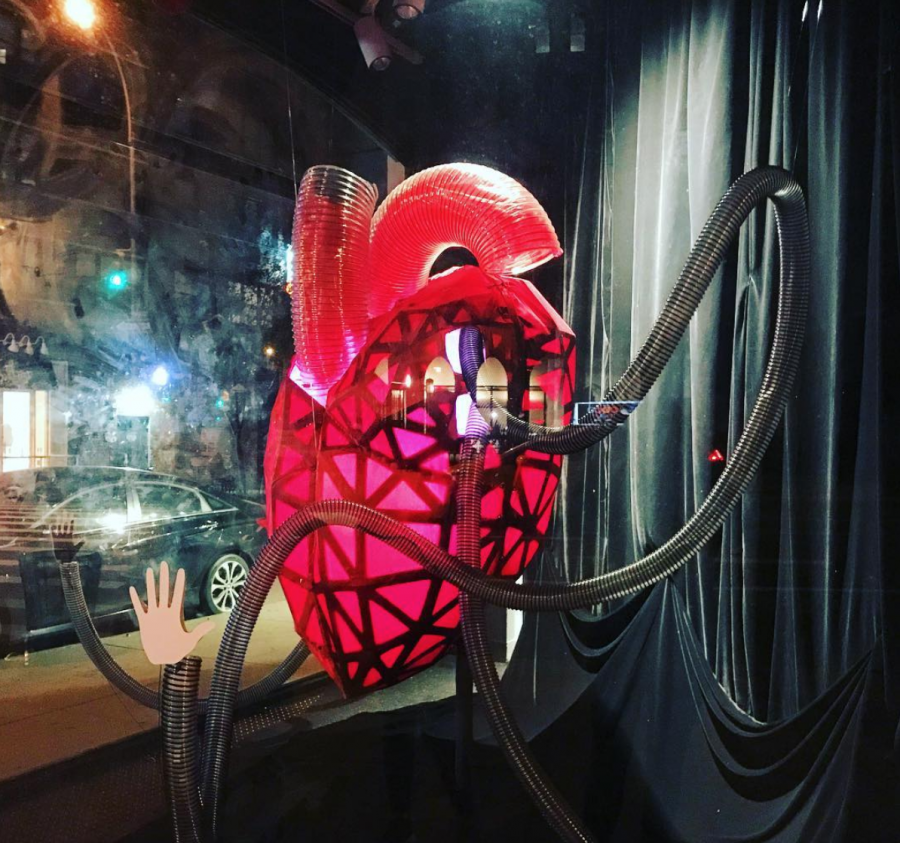Interactive Art at Broadway Windows
“CityBeat,” a giant heart that would light up through touching the sensors, was featured in Broadway Windows.
December 6, 2017
On the corner of Broadway and E. 10th St., an NYU establishment has been garnering a lot of attention as of late. Broadway Windows, situated in front of NYU’s freshman dorm Brittany Hall, is a public extension of 80WSE, a gallery run by NYU.
One recent exhibition has been especially popular. Consisting of five different projects spread out amongst the space’s six windows, the exhibition was the final presentation of “Pop Up Window Displays,” a graduate course taught by Professor Gabe Barcia-Colombo. The class is a part of the Interactive Telecommunications Program, a two year graduate program at Tisch School of the Arts. The pieces varied in style and subject, yet all shared a common element of interactivity, drawing attention from those both in and out of the NYU bubble.
The first piece “The Metatorium,” consisted of six monitors, a collection of wires and lights and two cameras. The exhibit would capture the face of those looking at it. The main monitor would display the camera feed, while two above it showed a digitally modified feed from the other camera. To the right, the upper monitor would capture the face of the passerby, and the lower monitor would add that to its list of previously captured faces. On the bottom left, another monitor showed what seemed like code, but would interact with the people at the exhibit, noting things such as the viewer smiling or dancing.
The next window featured “The City That Never Sinks,” involving a scenario where Manhattan drowns due to climate change. Included in its presentation were parodies of common city sights, like an advertisement for the “Museum of Wet” or an “If You See Something, Say Something” poster featuring the image of a scuba diver. Viewers of the exhibit could control a claw by visiting a website on their phones. The claw would knock table tennis balls with faces drawn on them into the water.
The main window, “CityBeat,” seemed to be the exhibition’s most popular attraction. In the middle of the display was a giant heart while vessels from the heart traveled to the windows. The vessels were attached to sensors which, upon a viewer putting their hands onto the sensors, sent a stream of light through the vein into the heart. The sensors, being on both windows, allowed for two people to participate simultaneously.
The two attractions to the right of “CityBeat” were titled “Winter’s Tale” and “Tea Party.”
“Winter’s Tale” involved a large storybook and festive decorations. A Kinect controller watched over visitors, allowing them to move their arms to turn the pages of the book. “Tea Party” contained the decor of a children’s room and had a carousel with toys attached. Those who passed by could move the carousel, and once it landed on a new toy, a related event happened in a monitor with a CGI rendering of a tea party.
This exhibit displays an innovative way to explore the combination of art and technology. Many of those who saw the attractions were visibly amazed by the capabilities presented. If you wanted to experience future exhibits for yourself, Broadway Windows is, by nature, free and open to the public, so keep an eye out for any future exhibitions hosted at the site.
Email Joshua Jones at [email protected].























































































































































